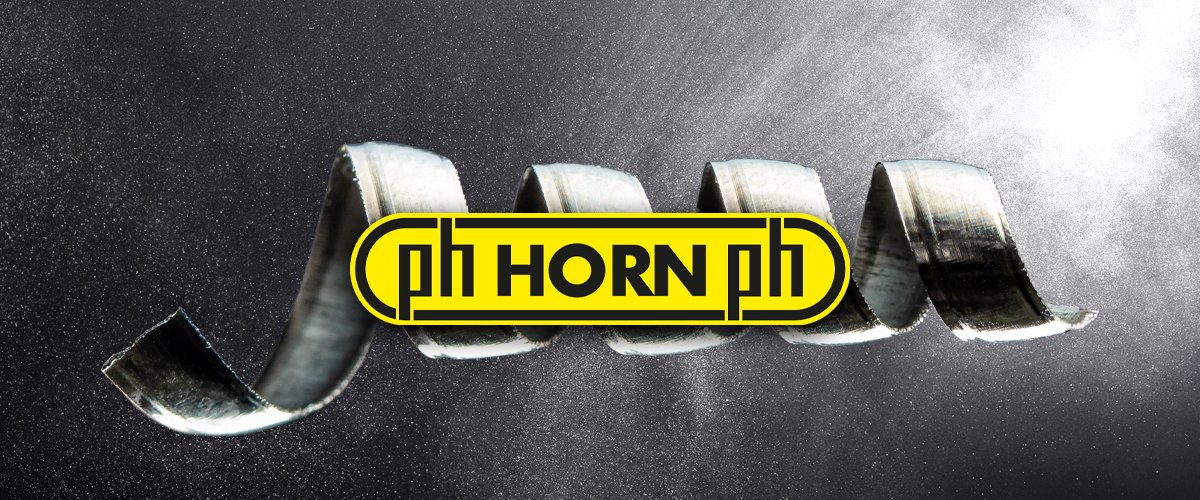Erleben Sie HORN
From tool to solution

Wearing mouth and nose protection reduces of the risk of airborne infection (via droplets) of the SARS-CoV2 coronavirus considerably. The enormous demand for masks in Germany is a major challenge and numerous companies are working on making products and solutions to meet this demand. One of the companies is Weber Ultrasonics AG from Karlsbad in the southern region of Baden in Germany. Weber is one of the leading manufacturers of ultrasonic welding equipment for mask production. To increase process reliability when manufacturing components from materials that are sometimes difficult to machine, production manager Sebastian Weiss’s team made several adjustments. The focus was on the tool concept previously employed to produce an important face groove. In addition to new tools, the Baden-based company also even changed the coolant. They were able to find the ideal partners for this in HORN and lubricant manufacturer Zeller+Gmelin.
By the end of June 2021, Germany should be able to produce up to seven billion protective masks a year, according to the Federal Ministry for Economic Affairs and Energy. As stated in the report, this includes certified FFP2, FFP3 and surgical face masks. The ministry is investing in this by providing over 60 million euros of subsidies. The aim of the state subsidy programme is to support production facilities making PPE and medical devices to protect patients alongside their primary products to ensure sufficient availability of personal and medical protective equipment to combat the coronavirus pandemic. As a first step, the personal protective equipment funding guideline is supporting investment in building and expanding systems to produce non-woven filter material using the melt blowing process. If the manufacturer is producing the masks as a medical product exclusively for medical use, they are subject to the European Medical Device Directive and must meet the corresponding requirements of the Medical Device Regulation.
Ultrasonic welding is used to produce surgical masks made of non-woven materials, as well as for medical components like membranes, adapters and connectors, functional components, blood filters and surgical instruments. What’s more, medical packaging and products for wound dressing and hygiene place special requirements on the weld and seal quality.
During the welding process, mechanical vibrations at an ultrasonic frequency are introduced into the materials being welded via a specific tool – the sonotrode. The molecular and surface friction produces heat, which melts the plastic in the specific location defined by the sonotrode. At the end of the welding process, a short cooling phase is required with the pressure still applied to cure the previously plasticised material homogeneously. After that, the connected parts can be processed further straight away.
Important face groove
Weber Ultrasonics produces all of the components and assemblies for its ultrasonic systems itself. For a titanium component in the converter, the machining technicians at Weber were worried about process reliability when producing a face groove. It is used for acoustic decoupling of the converter housing and has particular requirements in terms of precision and surface quality. “We produce the bottom part of the converter in different variants. The component is designed using FEM analysis according to its purpose. We need the precision and surface quality for uniform oscillation,” explains Weiss. One of the most important characteristics relating to the oscillations is that they may only be transferred in the axial direction, not in the radial direction. When producing the key face groove, the company had problems achieving uniform precision and satisfactory tool life due to unwanted vibrations, which led to chatter marks on the surface of the deep grooves.
After looking in-depth at the current machining process, Robin Roos, team leader in mechanical production, contacted the HORN field sales force. Jürgen Schmid, product and project manager in the Sales Department, took a close look at the grooving process and suggested testing the HORN S15A face grooving system. “As there are numerous variants of the lower part of the converter, we are also using a cartridge clamping system to reduce setup times and increase flexibility,” explains Schmid. Even after the initial trials, there was a clear improvement in terms of service life, process reliability and surface quality. “The problem with the tools used previously was that the service life was between
2 and 100 grooves. The HORN insert was very stable straight away,” says Roos.
New coolant
Schmid also suggested replacing the coolant that was in use with a new development from lubricant manufacturer Zeller+Gmelin. The Zubora TTS coolant is the result of a joint project between HORN, Zeller+Gmelin and a major machine tool manufacturer. “The idea behind the project was to develop a new, more effective product for machining superalloys. Zeller+Gmelin has achieved that with the new coolant. It is also worth emphasising that all of the experience of the lubricant manufacturer, the machine builder and the tool manufacturer was incorporated into the development,” explains Schmid. “After successful tests on different superalloys, it was time for the first field test at Weber Ultrasonics,” says Thorsten Wechmann, the product manager responsible for the development at Zeller+Gmelin. He continues: “By using Zubora TTS, it was possible to increase tool service life significantly. In addition, the completely new formulation improves the surface quality of the component. What’s more, it was possible to increase the cutting parameters and therefore improve profitability long term.”
As a result of this joint success, Weiss replaced all of the tools used previously for the critical face grooving operation with the system from HORN. “We wanted the tools to come from just one manufacturer – same system, shorter setup times, greater reliability,” explains Weiss. He uses full radius facegrooving inserts from the S15A system in 2 mm (0.079") and 3 mm (0.118") widths. The IG35 coating is used for machining titanium and other superalloys. Thanks to HiPIMS coating technology, the coating exhibits very smooth properties and high heat resistance. Furthermore, it is free from coating defects such as droplets or other faults at the cutting edge. Each insert now has a service life of 100 components. The tool system used previously had a service life of 35 on average.
Special tools in no time
HORN supplied Weber with various cartridges for holding the numerous tool variants: “We changed everything over in just three months. We didn’t just need the standard cartridges, but some special ones too. HORN is also able to supply special tools in no time at all,” says Weiss. For the key face groove alone, Weiss created a labelled drawer with part numbers and associated cartridges. Chip management has also been improved considerably with the combination of the new tool and the new coolant. “The combination of the new strategy of tool and coolant now gives us the opportunity to produce
50 parts in an unattended ghost shift. We no longer have problems with chips that are out of control in terms of their length,” Roos describes.
The new Zubora TTS coolant is a fully synthetic solution with a concentration of 8 to 10 per cent. With the new concept, the focus was on lubrication, supporting chipbreaking and improving surface quality. “We developed the new coolant for the productive machining of titanium and other superalloys. However, the product is multifunctional and brings numerous advantages when processing other materials,” explains Wechmann.
Weber and HORN have been working together for a few years. However, they only starting collaborating closely at the start of this project. Weiss is pleased with how things have gone: “HORN understood our requirements immediately and implemented them quickly and professionally. Jürgen Schmid’s idea to test the new Zeller+Gmelin coolant met all of our expectations for the project.”
Weber Ultrasonics:
Weber Ultrasonics AG develops, produces and sells solutions and components for the industrial use of ultrasonic technology. It focuses on cleaning, welding and cutting with ultrasound and includes other special types of application. In April 2020, Weber Ultrasonics was confirmed as an operator of critical infrastructure (KRITIS) and was also awarded the “Innovativ durch Forschung” seal of approval by the Stifterverband für die Deutsche Wissenschaft, an organisation that promotes German science. This seal is given to companies providing innovation through research. The company is certified to DIN EN ISO 9001 and has already been honoured several times for its exemplary company management. The family-run, medium-sized company based in Karlsbad employs over 160 people globally.
Zeller+Gmelin:
Zeller+Gmelin GmbH & Co. KG was founded in 1866 and employs over 900 people, almost half of whom are based at the headquarters in Eislingen. With its 15 subsidiaries, the medium-sized company operates around the world. Its product portfolio is split into three business areas: lubricants, industrial chemicals and printing inks. These high-quality products occupy a leading position on the international market. Zeller+Gmelin offers customised, comprehensive solutions from a single source, from research and development right through to production. R&D is extremely important at the company. In fact, around 20 per cent of the employees in Eislingen work in this department to constantly develop and optimise the innovative products to meet market and customer requirements.




